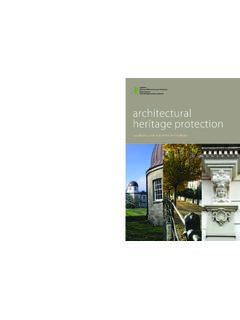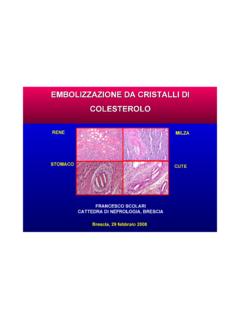Transcription of IN TRADITI ONAL BUILDING S ruins
1 The Advice Series is a series of illustrated booklets published by the Architectural Heritage Advisory Unit of the Department of the Environment, Heritage and Local Government. The booklets are advice series designed to guide those responsible for historic buildings on how best to repair and maintain their properties. advice series advice series advice series maintenance A GUIDE TO THE CARE OF OLDER BUILDINGS. bricks A GUIDE TO THE REPAIR OF HISTORIC BRICKWORK. iron THE REPAIR OF WROUGHT AND CAST IRONWORK. advice series advice series advice series roofs A GUIDE TO THE REPAIR OF HISTORIC ROOFS. energy IN TRADITIONAL BUILDINGS. windows A GUIDE TO THE REPAIR OF HISTORIC WINDOWS. ruins ruins THE CONSERVATION AND REPAIR OF MASONRY ruins . This gui de gives advice to those r esponsi ble for the car e of historic ruins on: maintaining a historic ruin identifying common defects Government of Ireland 2010.
2 Choosing the correct repair method Price a10. getting the right advice THE CONSERVATION AND REPAIR OF MASONRY ruins . ruins THE CONSERVATION AND REPAIR OF MASONRY ruins . DUBLIN. PUBLISHED BY THE STATIONERY OFFICE. To be purchased directly from: Government Publications Sales Office Sun Alliance House Molesworth Street Dublin 2. or by mail order from: Government Publications Postal Trade Section Unit 20 Lakeside Retail Park Claremorris Co. Mayo Tel: 01 - 6476834/37 or 1890 213434; Fax: 01 - 6476843 or 094 - 9378964. or through any bookseller Government of Ireland 2010. ISBN 978-1-4064-2445-4. All or part of this publication may be reproduced without further permission provided the source is acknowledged. The Department of the Environment, Heritage and Local Government and the authors accept no liability for any loss or damage resulting from reliance on the advice contained in this booklet Text by: Margaret Quinlan with Mary Hanna and David Kelly Contributors: John Feehan, Willie McErlean, Dave Pollock, Aidan Smith Editorial team: Aighleann O'Shaughnessy, Margaret Keane, Jacqui Donnelly All images are by the authors or DoEHLG, unless otherwise stated Series Editor: Jacqui Donnelly Copy Editor: Anna Kealy Design: Bennis Design Cover image: Abbey and Hospital of St Mary d'Urso, Drogheda, County Louth ruins THE CONSERVATION AND REPAIR OF MASONRY ruins .
3 Contents INTRODUCTION 5. 1. TRADITIONAL MASONRY CONSTRUCTION IN IRELAND 8. Prehistoric stone structures 8. Mediaeval masonry buildings 8. Post-mediaeval masonry buildings 10. ruins found today 12. Materials 13. Types of masonry construction 16. Features of masonry walls 19. 2. APPROACH TO MAINTENANCE AND REPAIR 27. Recording and assessment by the owner or custodian 27. Checklist for owners or custodians 29. Getting the right advice 29. What to expect from a professional advisor 30. Level of recording 30. Preventive maintenance 31. 3. COMMON DEFECTS FOUND IN RUINED STRUCTURES 34. Damage from vegetation 34. Foundation failures 35. Defects in walls 35. 4. PLANNING FOR REPAIR 44. Principal materials used in repair 44. Temporary works 47. Providing access 48. Loose carved stone and other artefacts 49.
4 Dealing with vegetation 49. 5. REPAIR TECHNIQUES 51. Underpinning foundations 51. Wall cappings 51. Stitching 52. Rebuilding collapsed masonry 52. Partial dismantling and rebuilding 52. Repairs to leaning walls 53. Repairs to failing arches 54. 3. ruins THE CONSERVATION AND REPAIR OF MASONRY ruins . Repairs to failing lintels 54. Replacement stones 54. Repointing 55. Grouting rubble masonry 55. Protection of carved stone and other decorative features 56. Shelter coats 56. Surviving plaster, render or slate-hanging 56. Surviving timber or evidence of timber 56. Surviving floors or paving 57. Dealing with emergencies such as collapse 57. Distinguishing between old and new in repair work 57. The use of consolidants 58. Stone cleaning 58. Lichen growth on stone 58. 6. ARCHAEOLOGY 59.
5 Archaeological testing and monitoring requirements 59. Sub-surface archaeology 59. Site works 59. Removal of tree roots 60. Collapsed masonry 60. 7. OTHER IMPORTANT ISSUES 64. Setting 64. Floodlighting 64. Lightning protection 65. Ecological and wildlife issues 65. Farming practices 66. Structures accessible to the public 66. Burials 66. Reuse of ruins 67. GLOSSARY 70. 4. ruins THE CONSERVATION AND REPAIR OF MASONRY ruins . Introduction It will have been seen that this is a country of ruins . of changed economic circumstances that made their Lordly or humble, military or domestic, standing up function redundant or upkeep impossible. Often, the with furious gauntness or shelving weakly into the later grander BUILDING nearby tells of an increase in soil, ruins feature the landscape uplands or river prosperity rather than decline.
6 The adaptations of the valleys and make a ghostly extra quarter to towns. buildings of the past are themselves records of change They give clearings in woods, reaches of mountain or and illustrate the scale of transition visible in the sudden turns of a road a meaning and pre-inhabited landscape of this country. Each survival is a document air. Ivy grapples them; trees grow inside their doors; that embodies a social, cultural and economic history. enduring ruins , where they emerge from ivy, are the limestone white-grey and look like rocks. Interest in the ruins of the past has deep roots. The Enlightenment of the eighteenth century laid the From Bowen's Court by Elizabeth Bowen, 1942 foundation for the development of antiquarian interest in the built relics of the past, leading in time to ruins are the surviving remnants of structures whose the formal study of archaeology and architecture.
7 This function came to an end some time in the past. In interest was overlaid with appreciation of the many cases these remnants bear witness to the picturesque. In the eighteenth and nineteenth manner of that end: for some it was accidental; for centuries, antiquarian illustrators and scholars - others it was violent, through deliberate destruction in Beranger, Grose, Petrie and Du Noyer among others - one of the many episodes of warfare that punctuate documented the views, buildings and antiquities of the story of Ireland; or through a political act such as the Irish countryside through drawings, paintings and the dissolution of the monasteries. prints that evoked a magical and sometimes desolate land. Ivy-clad ruined castles, monasteries and forsaken For others the evidence is different: the unroofed churches convey a picture of melancholic beauty that house, the clach n or the abandoned shell of a mill tell accorded with the romantic spirit of the times.
8 5. ruins THE CONSERVATION AND REPAIR OF MASONRY ruins . Our purpose here is to help owners to retain these ruins as documents, as evidence, as object lessons, as things of beauty and as inspirations, and to do so without changing their essential character. They retain intrinsic archaeological, architectural and historic importance. Many have become associated with the surrounding landscape and are beautiful in themselves. Some ruined structures, because of their national importance, are protected by being in the ownership or guardianship of the State; these are mostly structures dating from before 1700 AD. Bodies such as local authorities and religious authorities may also be the owners of many ruined structures, particularly mediaeval or later churches, where ownership includes the BUILDING and its surrounding graveyard.
9 Some community groups have been formed to take responsibility for a neglected historic feature in their area which has local significance. Interest in the study of ancient ruins grew throughout the second half of the eighteenth century and into the nineteenth century. Many artists and antiquarians published collections of topographical images which are now invaluable sources of reference. This drawing of Jerpoint Abbey, County Kilkenny by Edward Cheney is dated 1837. (Image courtesy of the Office of Public Works). ruins became a prized feature of the designed Romantic landscape to the point where, if one did not have a convenient authentic ruin, a sham could be constructed as an eye catcher' or focal point in a vista. Towers and temples modelled on icons of classical Lynally Glebe, County Offaly.
10 Many rural graveyards architecture and built as elements in the picturesque in local authority ownership or control contain the landscape are nowadays often themselves ruins . ruins of early mediaeval churches which are Mediaeval buildings, in particular, acquired an almost included in the Record of Monuments and Places moral status, representing an imagined ideal past and offering a model of hope for the future. This status was also expressed in the nineteenth century by the There are thousands of ruined structures in the adoption of mediaeval styles for new church buildings, ownership of individuals. These can range from tower as well as in the restoration and rebuilding of existing houses, grain stores and mills to limekilns and churches. At times, the works of the past became a vernacular farm buildings.







